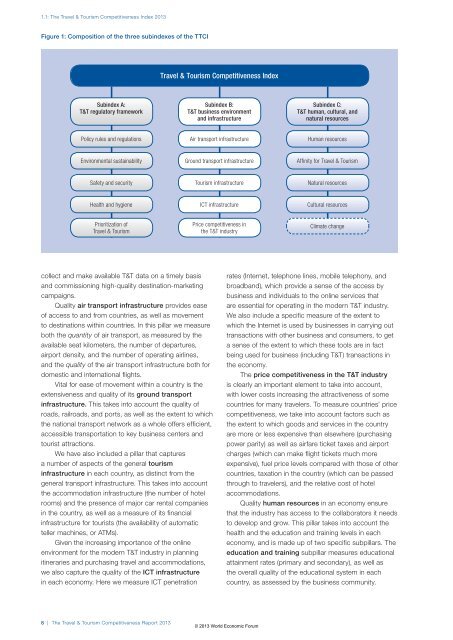The Travel & Tourism Competitiveness Report 2013
The Travel & Tourism Competitiveness Report 2013
The Travel & Tourism Competitiveness Report 2013
Create successful ePaper yourself
Turn your PDF publications into a flip-book with our unique Google optimized e-Paper software.
1.1: <strong>The</strong> <strong>Travel</strong> & <strong>Tourism</strong> <strong>Competitiveness</strong> Index <strong>2013</strong><br />
Figure 1: Composition of the three subindexes of the TTCI<br />
Subindex A:<br />
T&T regulatory framework<br />
Policy rules and regulations<br />
Environmental sustainability<br />
Safety and security<br />
Health and hygiene<br />
Prioritization of<br />
<strong>Travel</strong> & <strong>Tourism</strong><br />
collect and make available T&T data on a timely basis<br />
and commissioning high-quality destination-marketing<br />
campaigns.<br />
Quality air transport infrastructure provides ease<br />
of access to and from countries, as well as movement<br />
to destinations within countries. In this pillar we measure<br />
both the quantity of air transport, as measured by the<br />
available seat kilometers, the number of departures,<br />
airport density, and the number of operating airlines,<br />
and the quality of the air transport infrastructure both for<br />
domestic and international flights.<br />
Vital for ease of movement within a country is the<br />
extensiveness and quality of its ground transport<br />
infrastructure. This takes into account the quality of<br />
roads, railroads, and ports, as well as the extent to which<br />
the national transport network as a whole offers efficient,<br />
accessible transportation to key business centers and<br />
tourist attractions.<br />
We have also included a pillar that captures<br />
a number of aspects of the general tourism<br />
infrastructure in each country, as distinct from the<br />
general transport infrastructure. This takes into account<br />
the accommodation infrastructure (the number of hotel<br />
rooms) and the presence of major car rental companies<br />
in the country, as well as a measure of its financial<br />
infrastructure for tourists (the availability of automatic<br />
teller machines, or ATMs).<br />
Given the increasing importance of the online<br />
environment for the modern T&T industry in planning<br />
itineraries and purchasing travel and accommodations,<br />
we also capture the quality of the ICT infrastructure<br />
in each economy. Here we measure ICT penetration<br />
8 | <strong>The</strong> <strong>Travel</strong> & <strong>Tourism</strong> <strong>Competitiveness</strong> <strong>Report</strong> <strong>2013</strong><br />
<strong>Travel</strong> & <strong>Tourism</strong> <strong>Competitiveness</strong> Index<br />
Subindex B:<br />
T&T business environment<br />
and infrastructure<br />
Air transport infrastructure<br />
Ground transport infrastructure<br />
<strong>Tourism</strong> infrastructure<br />
ICT infrastructure<br />
Price competitiveness in<br />
the T&T industry<br />
Subindex C:<br />
T&T human, cultural, and<br />
natural resources<br />
Human resources<br />
Affinity for <strong>Travel</strong> & <strong>Tourism</strong><br />
Natural resources<br />
Cultural resources<br />
Climate change<br />
rates (Internet, telephone lines, mobile telephony, and<br />
broadband), which provide a sense of the access by<br />
business and individuals to the online services that<br />
are essential for operating in the modern T&T industry.<br />
We also include a specific measure of the extent to<br />
which the Internet is used by businesses in carrying out<br />
transactions with other business and consumers, to get<br />
a sense of the extent to which these tools are in fact<br />
being used for business (including T&T) transactions in<br />
the economy.<br />
<strong>The</strong> price competitiveness in the T&T industry<br />
is clearly an important element to take into account,<br />
with lower costs increasing the attractiveness of some<br />
countries for many travelers. To measure countries’ price<br />
competitiveness, we take into account factors such as<br />
the extent to which goods and services in the country<br />
are more or less expensive than elsewhere (purchasing<br />
power parity) as well as airfare ticket taxes and airport<br />
charges (which can make flight tickets much more<br />
expensive), fuel price levels compared with those of other<br />
countries, taxation in the country (which can be passed<br />
through to travelers), and the relative cost of hotel<br />
accommodations.<br />
Quality human resources in an economy ensure<br />
that the industry has access to the collaborators it needs<br />
to develop and grow. This pillar takes into account the<br />
health and the education and training levels in each<br />
economy, and is made up of two specific subpillars. <strong>The</strong><br />
education and training subpillar measures educational<br />
attainment rates (primary and secondary), as well as<br />
the overall quality of the educational system in each<br />
country, as assessed by the business community.<br />
© <strong>2013</strong> World Economic Forum

















